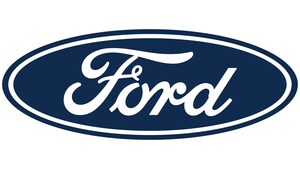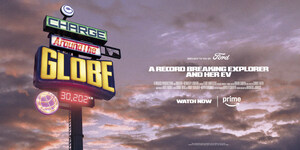New Fiesta Closes in on 1 Million Sales; Helps Accelerate Ford's Global Growth Strategy
PARIS, Sept. 30 /PRNewswire/ --
- Fiesta attracting new customers to Ford around the world as global tastes converge around smart design, intuitive technology and connectivity, features and content normally found in larger vehicles
- Nearly 1 million new Fiestas have been sold globally in more than 100 markets since October 2008; Fiesta is produced in five plants around the world
- Fiesta is the first vehicle built on Ford's global B-platform, which is expected to underpin 1.6 million vehicles per year by 2014
- Fiesta is attracting, younger and more affluent buyers to Ford brand than previous models and a higher percentage of buyers trading in models from competing brands; buyers also are choosing higher trim levels with more features and options than Ford expected
Less than two years after its global rollout began in Europe, the Ford Fiesta is exceeding expectations – attracting a new breed of younger and more affluent customers to the Ford brand – and stands as the strongest proof yet that the One Ford plan is working.
The new Fiesta, produced in five plants in Europe, Asia and North America and sold globally in more than 100 markets, is expected to reach the 1 million sales mark in October.
"The Fiesta's success shows the advantages of operating as One Ford and truly leveraging our scale and expertise," said Alan Mulally, Ford president and CEO. "We worked together to design and build a great small car for the world – with leading quality, safety, fuel economy, smart design and value – and nearly a million customers have responded."
Fiesta is the first vehicle built on Ford's global B-platform. Ford is targeting 1.6 million annual sales from vehicles built on the global B platform in 2014.
"The efficiencies we gained by leveraging our global scale allowed us to deliver a new Fiesta that both exceeds customer expectations for small cars and contributes to a healthy and profitable growing Ford," Mulally said.
By 2013, Ford will have reduced its core platforms to 12 from 25 in 2009. By then, more than 80 percent of its volume globally will be produced off those core platforms, up from about 50 percent in 2009.
Demographic data show the expressive new Fiesta sedans and hatchbacks are attracting younger, more affluent and more highly educated customers than the prior model Fiesta and other Ford products.
"Smart design and intuitive technology are highly valued in the global marketplace," said Jim Farley, Ford group vice president, Marketing, Sales and Service. "Fiesta is proving that consumers don't want a 'dumb-downed' small vehicle. Millennials are particularly interested in smart design, technology and high-end features, and they're willing to invest in them."
1 Million New Fiestas
The new Fiesta launched in Europe in October 2008. In 2009, Ford started producing and selling Fiesta in China and other Asian markets, Australia and South Africa. This summer, the Fiesta was introduced in North and South America and started to rollout across Southeast Asia in September.
Ford expects more than 1 million new Fiestas will be sold in its first two years in global markets. Through August 2010, regional sales tallies were:
Europe |
810,000 |
|||
Asia Pacific Region |
120,000 |
|||
North America |
10,000 |
|||
Total |
940,000 |
|||
Reaching Global Customers
Today, Ford produces the Fiesta at five assembly plants – Cologne, Germany; Valencia, Spain; Nanjing, China; Cuautitlan, Mexico; and Rayong, Thailand.
While Ford has successfully found high-quality, cost-effective ways to develop and deliver the tooling for these global cars, marketing Fiesta around the world also has been challenging because of the diversity of customers.
In markets where Fiesta is a new nameplate to customers, such as China, Southeast Asia and the United States, Ford used digital and social media extensively to create pre-launch awareness.
"The use of social media provided authentic consumer impressions," said Farley. "This medium provided a level of credibility that would not have been possible with traditional marketing campaigns."
The Fiesta Movement – where web-savvy, often younger people – are given Fiestas to drive for extended periods and chronicle their experiences before the vehicle goes on sale – proved an effective way to spread the word about the new Fiesta. It was used in China, Taiwan, United States and now South America.
"The idea for the Fiesta Movement actually came from China, where the Fiesta also was launched using social media," Farley said. "Now, we are launching the Fiesta in South America and Thailand using this approach. It was controversial to do this so far in advance of the actual product launch in the market, but we needed to take the risk in the U.S. where we did not have a B-segment product for 30 years."
More traditional campaigns were employed in Europe and Australia, where Fiesta had high nameplate recognition. These campaigns focused on modern themes – Fiesta's design leadership and technology. In Europe, the campaign theme was "This is Now" and Australia launched the new Fiesta on "Australia's Next Top Model" program.
Global marketing initiatives include the "Fiesta World Tour," a 15,000-mile, round-the-world trip, visiting 21 countries in 50 days. Another global initiative is the Fiesta Facebook page (www.facebook.com/fordfiesta), a multi-lingual site with video content and consumer postings from around the world. The Southeast Asia markets, in particular, have leveraged their respective Facebook pages to amass tens of thousands of highly engaged Fiesta fans ahead of launch.
Fiesta Attracting New Customers Worldwide
Europe: In Europe, the new Fiesta has brought a dramatic shift toward younger, more affluent and more highly educated buyers.
The new Fiesta draws 22 percent of its buyers from the 29 and under age group – five points higher than the prior model Fiesta. The five points gained in this group were taken from the 60-and-over age group. Buyers age 30 to 59 accounted for 53 percent in both the new and prior model car.
"This is a stunning shift in the customer profile," said Farley. "We did not expect to see significant movement in buyer age for an established nameplate in a mature market."
The Fiesta buyer in Europe also is more affluent and more highly educated than previous Fiesta buyers. Today's Fiesta draws 14 percent of its buyers from high income households – five points higher than for the prior model – and 57 percent are highly educated – 12 points higher than the prior model.
The "conquest" rate for the new Fiesta in Europe is 45 percent – six points higher than the prior model, meaning Fiesta is attracting more buyers from other brands.
Asia Pacific and Africa: In China, 54 percent of Fiesta buyers are age 29 and under and the average age is 30. In South Africa, 50 percent of the buyers are age 29 and under and the average age is 33. There was no prior model Fiesta in China and South Africa. The average age of the current Focus buyer in these markets is three years older than the new Fiesta buyer.
In Southeast Asia, Fiesta marks Ford's entry to the region's high-volume and high-growth B segment that largely caters to the booming under-30 demographic.
"In these markets, Fiesta is giving Ford a large footprint among the Millennials," said Farley. "Establishing an owner-body in this influential generation provides us an incredible opportunity for future growth."
In Australia, where Ford previously relied on sales of large sedans, the under-30 age group accounts for 32 percent of Fiesta sales, and the average age is 40.
United States: In the United States, the average age of the Fiesta buyer is 46, and 29 percent of the buyers are under 35. By comparison, the average age of the Focus buyer is 50, and 24 percent of Focus buyers are under 35.
The Fiesta's conquest rate in the U.S. is 57 percent – the highest for any Ford product in the U.S.
Higher Spec Levels
As shown in the table below, a common theme among Fiesta buyers is that they are choosing high levels of features and options:
High Series |
Mid-Series |
Low Series |
||
Europe |
42 % |
54 % |
4 % |
|
China |
28 |
67 |
5 |
|
Australia |
49 |
30 |
21 |
|
Thailand |
65 |
17 |
18 |
|
South Africa |
38 |
60 |
2 |
|
United States |
39 |
54 |
7 |
|
"Drawing a more affluent buyer results in high content levels," said Farley. "It is also a by-product of designing and engineering a world-class small car that customers really want to buy and love to drive."
Ford has learned and applied a number of lessons learned to its next global product – the next-generation Focus. It will be launched simultaneously in Europe and North America and go on sale in early 2011, and then be launched in other markets around the world. Focus is developed on Ford's global C-platform, which is expected to deliver 2 million vehicles annually by 2012.
"The Fiesta has validated our belief that customers really value great small cars no matter where they live in the world," Mulally said. "This gives us great confidence in our plan as we prepare to launch the new global Focus later this year."
About Ford Motor Company
Ford Motor Company (NYSE: F), a global automotive industry leader based in Dearborn, Mich., manufactures or distributes automobiles across six continents. With about 159,000 employees and about 70 plants worldwide, the company's automotive brands include Ford, Lincoln and Mercury, production of which has been announced by the company to be ending in the fourth quarter of 2010. The company provides financial services through Ford Motor Credit Company. For more information regarding Ford's products, please visit www.ford.com.
SOURCE Ford Motor Company
WANT YOUR COMPANY'S NEWS FEATURED ON PRNEWSWIRE.COM?
Newsrooms &
Influencers
Digital Media
Outlets
Journalists
Opted In



Share this article